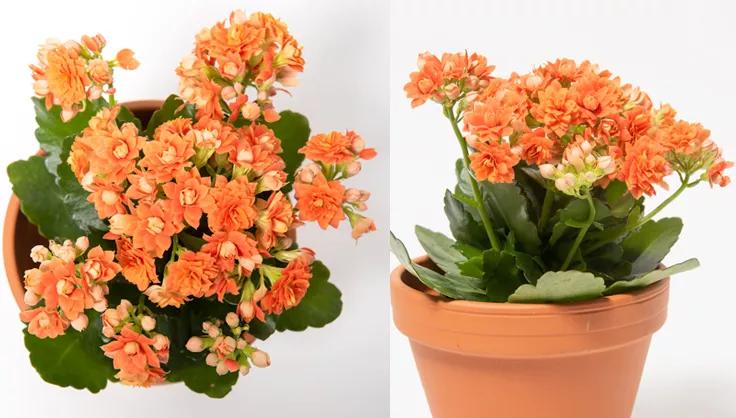How To Grow & Care For Kalanchoe

K blossfeldiana is hardy outdoors in zones 10-12, where it can be grown as a perennial — it begins to suffer in temperatures lower than 45 degrees Fahrenheit and thus, must be grown as a houseplant in cooler grow zones. Read on and learn how!
Types and Cultivars of Kalanchoes to Try
There are well over 100 different Kalanchoe varieties, with the most popular being the Kalanchoe blossfeldiana. Also try:
Kalanchoe blossfeldiana 'Queen Jodie': this Kalanchoe boasts elegant pink double blooms that almost resemble tiny roses.
Kalanchoe blossfeldiana ‘Flaming Katy’: with its vivid clusters of bright red flowers, this cultivar has certainly earned the “flaming” namesake.
Kalanchoe tomentosa: known as Panda Plant, this succulent offers an intriguing texture with its fuzzy leaves; a great addition to a sensory garden!
Kalanchoe thyrsiflora: with its large, paddle-like leaves, this succulent is often known as Flapjacks plant, and is sometimes confused with the more common and nearly identical K. luciae.
Best Conditions For Kalanchoe
Light: Kalanchoes thrive in bright, indirect sunlight. A south-facing window that receives plenty of light is ideal. While they can tolerate some direct sunlight, too much can cause their leaves to scorch.
Soil: As succulents, Kalanchoes do not like waterlogged roots. Use a well-draining potting mix, ideally one formulated for cacti, or mix your own, using a 1:1 ratio of regular potting mix and gritty gravel.
Humidity: As a drought-tolerant succulent, Kalanchoes are suited to arid conditions and will handlee standard room humidity just fine.
How To Care For Kalanchoes
Watering
As succulents, Kalanchoes need minimal water. Allow the soil to dry out completely between waterings, and then water deeply. Overwatering can lead to root rot, so it’s important to avoid letting the plant sit in water.
Fertilizing
Kalanchoes are not heavy feeders and will thrive without any fertilizer. Should you choose to fertilize, use a balanced, water-soluble fertilizer diluted to half-strength during the summer growing season.
Pruning
Pruning isn’t usually necessary, but deadheading spent flowers can encourage new blooms. You can also prune back leggy growth to maintain a compact, bushy shape. When grown indoors as a houseplant, most Kalanchoe remain around 12 inches tall.
Repotting
Regular repotting can encourage Kalanchoe to pump out more blooms! Repot Kalanchoes in fresh potting mix every 1-2 years. Choose a container that’s slightly larger than the current one and ensure it has good drainage. Clay or terracotta pots dry quickly and can also promote good drainage.
Propagation
Kalanchoes are easy to propagate. You can do this by leaf or stem cuttings. Simply place the cuttings in soil, and they will root and grow into new plants.
Common Problems with Kalanchoes
Pests and Diseases: Common pests include aphids and mealybugs. Keep an eye out for signs of infestation, such as sticky residue on leaves or small, cottony spots.
Signs of Stress: The most common problem is overwatering, which can lead to root rot. Leaves will start to yellow and stems may feel soft and mushy.
Toxicity
Kalanchoes are toxic to pets if ingested, particularly cats and dogs. It’s best to keep these plants out of reach of curious pets.
Kalanchoes FAQs
Q: Why are my Kalanchoe's leaves turning yellow?
A: Yellowing leaves can be a sign of overwatering or poor drainage. Ensure your potting mix is well-draining and allow the soil to dry out between waterings.
Q: How can I get my Kalanchoe to bloom again?
A: Like chrysanthemums, Kalanchoe are “short-day plants”. To encourage blooming, Kalanchoes need short daylight hours for about 6 weeks. You can achieve this by placing the plant in complete darkness for 14 hours a day and then returning it to its normal spot.
Q: Can I grow Kalanchoe outside in a planter?
A: Yes! Hardy as a perennial in zones 10-12, Kalanchoe can also be grown as an annual in a container. Pair them in a planter with small aloes, a low-growing sedum, and other plants that have relatively low water requirements.
Brighten your indoor AND outdoor space with a splash of bold color! Kalanchoe are hardy plants, well-suited for gardeners of all levels, from beginners looking for an easy-care plant, to more experienced enthusiasts seeking a challenge in propagation.
Print this Article:
Get the Dirt
Stay up to date on new articles and advice. Please fill out the information below.

